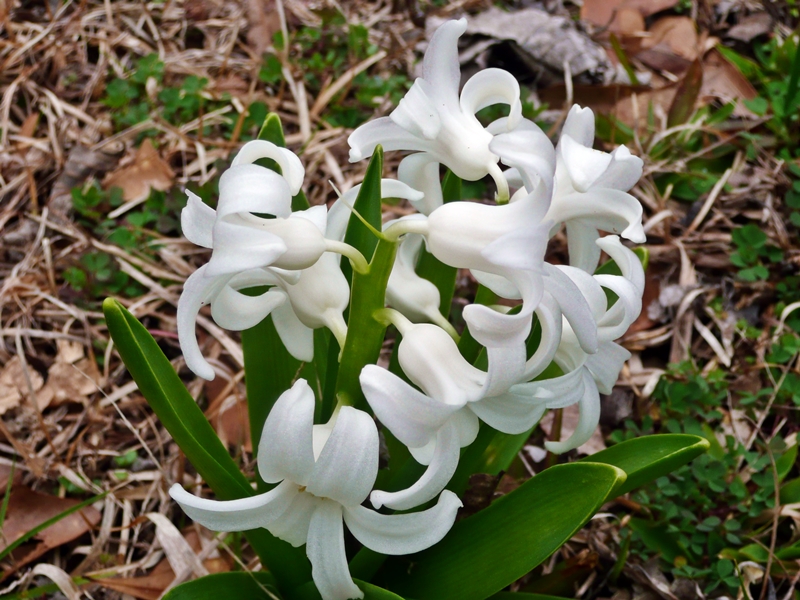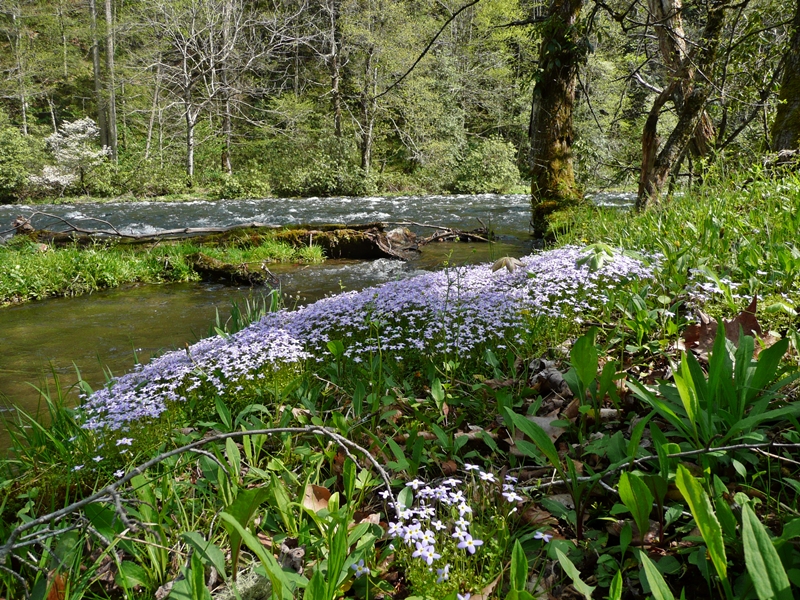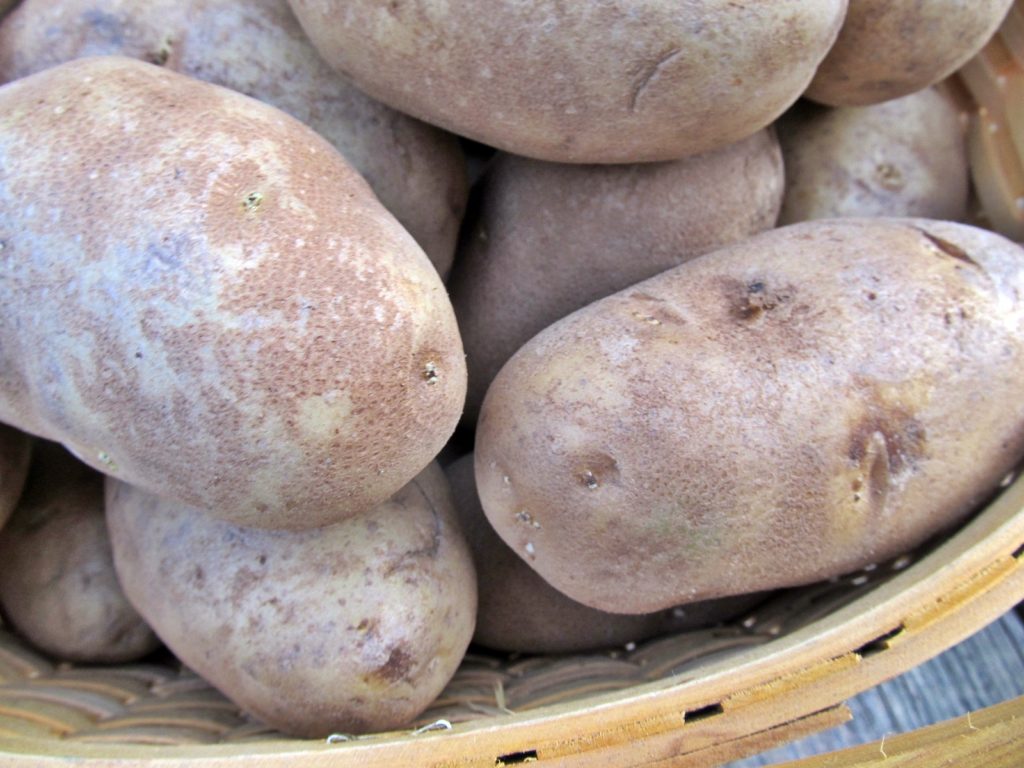THE MONTH OF MARCH:
DELIGHTFUL AND DISGRUNTLING

White hyancinth in full glory
I’m always glad when the month of March rolls around. It heralds all sorts of good things—rising trout, gobbling turkeys, blooming wildflowers, spring vegetables in the garden, poke salad, dandelion greens—all are in the offing just a few weeks down the road. It also signals the beginning of the end to winter, although I have no doubt whatsoever that there are bitter breezes, killing frosts, and chilling rains yet to come before spring truly arrives. Nonetheless, buds on red maples are swelling, bluebirds are checking out a backyard box with a far more serious mien than is the case in their periodic stop-and-look ventures during the winter, dandelions are blooming, and pink is showing on the redbud in the back yard.

A patch of bluets alongside the Nantahala River
Still, there’s no doubt that the month of March can be both delightful and disgruntling. I reckon Old Will Shakespeare knew whereof he wrote when he cautioned “Beware of the Ides of March,” but then if you read the sweet swan of Avon enough realization eventually dawns that he knew something about pretty much everything. My Grandpa Joe was no bard, but he was a staunch son of the Smokies chock full of folk wisdom and witticisms. He used to call March the month of hope and renewal. “It’s really a pretty miserable month,” he would opine. “Hunting season is closed, it’s far too cold to fish for trout (that was in the days when everyone waded wet and, besides, the season in those days didn’t open until April in state waters and May in the Great Smoky Mountains National Park), and more often than not the weather is ornery.” Still, as he well knew, March meant that April and May weren’t far away, and just thinking of them lifts my spirits. “First thing you know,” he’d say, “we’ll have a mess of black-seeded Simpson lettuce from the garden, and by the end of the month anyone with a decent amount of gumption can gather a bait of dandelion greens.”
I don’t know about the garden side of things here in the present, because it’s rained so much it will take the better part of a fortnight and plenty of sunshine to get the ground dry enough to plow. But I can’t let that trouble me too much, because it seems with each passing month, and certainly each passing year, that I’m increasingly prone to reside, at least mentally, in the past.
Grandpa Joe was the same way, and come to think of it, at the point where I was absorbing much of his wisdom he was about the age I am now. Sitting comfortably in his rocking chair and warming to his subject, Grandpa Joe would reminisce about memorable experiences from his past associated with this general time of year—a late March snowstorm, “yarbing” (gathering herbs for medicinal use), making sweet syrup from maples (we think of that as something confined to more northern climates, but “tree sweetening” was once fairly common in the Smokies), and the like.
One of the things about March which fascinated me then as much as it does now was planning connected with planting gardens. Grandpa firmly believed in planting by the signs, and to that end he studied the Farmer’s Almanac and considered it absolute gospel. If the signs weren’t right seed potatoes would not go into the ground; and if the Almanac said it was a time for root crops to go the ground, then things like cabbage would just have to wait. I must confess that I think Grandpa was onto something. I don’t always plant by the signs, but his resounding and consistent success was such it pretty well shredded any arguments about planting when the spirit happened to move you. Moreover, last year my taters were a flat-out bust, after many years of bountiful crops of the Kennebecs I plant. I have no doubt whatsoever I put them in the ground at the wrong time.
Another fond memory from those long ago days focused on Grandpa’s discussion of turkeys. I never saw one of the grand birds until long after he was gone (he died when I was twenty-five years of age), but I had read about them in the writings of boyhood literary heroes such as Archibald Rutledge. I could identify with Rutledge to some degree because he hailed from neighboring South Carolina. Grandpa talked about the special sound gobblers made in the mating season, and according to him, “once you hear it you realize a bird can shake the ground and stir the soul.” Was he ever right on this score, as was the case on so many other things!

Bloodroot
It won’t be long until the rites of the spring woods once more arrive, and already thoughts of being in the woods at dawn move me to the depths of my soul. But then, so do simpler pleasures connected with early spring. To walk through woodlands where service trees add a splash of white to a grim, grey landscape, is to tread through wonder. The same holds true for glimpses of the first flowering bluets, bloodroots peeking through leaf mold, the shiny green of emerging Mayapple leaves, and the first pink of swelling redbud blooms. It’s also time, after the first rain followed by a warm spell, to start looking for morel mushrooms in this part of the world. Early spring uplifts in so many ways, and as I grow older I enjoy the profusion of wildflowers, a parade of color which becomes more beautiful as March gives way to April, and April to May, even more than I used to. Or maybe it would be more accurate to say that in the turkey woods or just wandering, I pause and ponder a bit more than used to be the case.

The arrival of March, for all that the wild turkey holds a corner of my soul, also holds great meaning for me as a lifelong fly fisherman. I poured my heart and soul into a book on pursuing the sport in my native heath, the Great Smokies, and if you love the long rod and whistling line and haven’t yet acquired it, I would humbly direct your attention to Fly Fishing in the Great Smoky Mountains National Park: An Insider’s Guide to a Pursuit of Passion. I consider it the most important book I’ve ever done now in print (I may change my view once A Smoky Mountain Boyhood appears—see below), but obviously I’m the last person to judge the true merits of this or any book I’ve written.
When I was a youngster the trout season always opened the first Saturday in April, a sharp contrast with the situation now, where some streams (all of those in the Great Smoky Mountains National Park) are open throughout the year. That meant building anticipation as March marched along, occasional walks along streams to look for insect life and see if any fish were rising, and maybe a sneak preview of fishing for knottyheads and bream in the nearby Tuckaseigee River.
Another aspect of March which I have always cherished is associated with the old mountain custom of taking “tonics” in this month. These took many and varied forms, from sulphur and molasses to thin the blood to infusions of sassafras tea for one’s general health. Spring greens such as poke salad did double duty as a purgative (as Grandpa Joe liked to say, “it will set you free”), and there were always some who thought even the most nauseous of nostrums could be rendered palatable by being taken with a good slug of peartin’ juice (for the uninformed, that’s moonshine) or honey. Not too long prior to his untimely arrest and subsequent suicide, I had the opportunity to discuss such matters with the late Popcorn Sutton. He was a genuine mountain character and lifelong producer and purveyor of corn squeezin’s. Popcorn’s studied opinion was that “a body needs some properly made likker, along with a mess of trout and bait of ramps and branch lettuce,” to get into spring in proper fashion.
I’m by no means certain Popcorn’s spring tonic was the best. He had more than a bit of the carnival barker or snake-oil salesman to him, and on top of that he absolutely loved to be in the spotlight. One way he achieved that was through often outrageous statements, and he had about as foul a mouth as I’ve ever heard. Had Grandma Minnie gotten hold of him, she would have washed his mouth out with a hefty amount of Octagon soap.
On the flip side of anything but sumptuous spring tonics, March is a month for some fine late winter eating. As these words are being written I’ve got a big pot of venison burger, okra, and tomatoes simmering away on the stove. After the flavors have had plenty of time to mix, marry, and mingle I’ll add rice to make a sort of mountain boy’s take-off on gumbo. The main difference is I don’t trouble with a roux and I go easy on the “heat” when it comes to spices. Right now the smells emanating from the kitchen have my salivary glands threatening to run amok, and I’ll interrupt this effort before long for some fine eating.
March is a time for some freezer cleaning out, a month for hearty soups, and a time for the simple pleasures of things such as a fine pone of cornbread or a big pot of pinto beans cooked with ham hock. In the past month I think I’ve had soup at least once every other day—a hearty potato soup I make (just potatoes, real butter, lots of milk, and salt and pepper), along with venison vegetable soup, split pea and ham soup, and more. I can eat it once a day in colder weather and be happy as a hog wallowing in mud hole on a hot July day. Add a big old slab of cracklin’ cornbread, and thanks to the son of a good buddy I recently got some real, old-time cracklin’s, and you are traveling along the culinary road to hillbilly heaven.
Over the next few weeks I’ll be spending more time doing yard work, weather permitting, and there’s always the urge to get into the greening-up woods to check for turkey sign and simply wander amidst the glories of the changing season. I love the freshness of spring, the infinite variety in terms of shades of green, the songs and antics of birds as they enter the mating season, and the mere joy of taking a step away from February. March isn’t quite as good as April, and April takes a back seat to May, but by golly all of them are far superior to little, often lousy February.
******************************************************************************
JIM’S DOIN’S
By far the most exciting news on the home front, other than waiting rather impatiently for enough of a change in the weather to let the ground get dry enough for tilling (I’m miles behind in spring gardening and can’t do anything about it), involves the book reflecting on boyhood experiences and life in the Smokies as I knew it when growing up. Things are moving along nicely. I’ve shared a whole batch of possible photographs with the folks at the University of Tennessee Press for possible use with the book, and they recently gave me the good news that they planned for A Smoky Mountain Boyhood: Memories, Musings, and More, to be the lead title in their Fall, 2020 catalog. Here’s the promotional material they shared with me as it presently reads:
“Born in Bryson City, North Carolina, Jim Casada has had a long career as a teacher, author, and avid outdoorsman. He grew up in a time and place where families depended on the land and their community to survive. Many of the Smoky Mountain customs and practices that Casada reflects on are gradually disappearing or have vanished from our collective memories.
“In A Smoky Mountain Boyhood, Casada pairs his gift for storytelling and his training as a historian to produce a highly readable memoir of mountain life in East Tennessee and western North Carolina. His stories evoke a strong sense of place and reflect richly on the traits that make the people of Southern Appalachia a unique American demographic. Casada discusses traditional folkways; hunting, growing, preparing, and eating wide varieties of food available in the mountain region; and the overall fabric of mountain life. Divided into four main sections—High Country Holiday Tales and Traditions; Seasons of the Smokies; Tools, Toys, and Boyhood Treasures; and Precious Memories—each part reflects on a unique and memorable coming-of-age in the Smokies.
“Containing a strong sense of adventure, nostalgic tone, and well-paced prose, Casada’s memoir will be appreciated by those who yearn to rediscover the Smokies of their childhoods as well as those who wish to imaginatively climb these mountains for the first time.
“Jim Casada was, until his retirement in 1996, a professor of history at Winthrop University. He is the author of seventeen books on history, the great outdoors, hunting, and fishing, including the award-winning Fly Fishing in the Great Smoky Mountains National Park: An Insider’s Guide to a Pursuit of Passion.”
I’m keeping a list of those interested in being notified when the book appears, and if you haven’t already contacted me in that regard and are interested, just let me know via e-mail (jimcasada@comporium.net).
Otherwise, look for an article of mine on legendary Smokies’ sportsman Mark Cathey in the Spring, 2020 issue of Smokies Life. This beautiful magazine, published twice annually by the Great Smoky Mountains Association, a support group for the national park, is visually most impressive and consistently contains some first-rate articles on the region and its past. I’m delighted to be among the contributors to the upcoming issue.
I continue working on a book profiling mountain characters and just finished the chapter on Lucinda Winchester Davis. A high school classmate with whom I have stayed in touch over the years brought this remarkable woman, who was her grandmother, to my attention. She lived to the age of 106, was a traditional mountain “granny woman,” a fervent believer in charismatic religion including some handling of snakes, but most of all an individual who periodically saw the future. There are far too many documented cases of this to argue otherwise. She will join thirty-eight other individuals in the book.
Finally, I’m plugging away on revising and refining a proposal for a cookbook to be co-authored with my good friend, webmaster, and distant cousin, Tipper Pressley. It will focus on the tastes and traditions of Appalachian foods and blend coverage of food ways with recipes.
***************************************************************************
THIS MONTH’S BOOK SPECIALS
Turkey hunting season lies just around the corner so it seems logical to focus attention on books connected with that sport. There’s a lengthy list of these, both new and out-of-print, on my website. From the point when you receive this through the end of April, all turkey hunting books will be 20% off AND come with free shipping. For this offer though, no PayPal please, just personal checks or money orders mailed to me at 1250 Yorkdale Drive, Rock Hill, SC 29730. South Carolina residents will need to include 7 percent sales tax. If you want to e-mail me in advance to hold the books or be sure I have a given item in stock, feel free to do so (jimcasada@comporium.net).
*************************************************************************
THIS MONTH’S RECIPES
HILLBILLY GUMBO
This isn’t gumbo in the traditional Cajun sense, mainly because the spices are different and the preparation simpler. Begin by browning enough ground venison or hamburger in a frying pan to equate to a small burger for each of the expected number of diners (or for how much you want to have in the way of leftovers). Place the browned meat and the grease which cooked out during the browning in a large stew pot. Add frozen okra and canned or frozen tomatoes. Incidentally, both okra and tomatoes are the essence of simplicity when it comes to freezing. Just dice them up and freeze fresh. It’s possible you will need to include a bit of water, but if the tomatoes are juicy ones (I just use those I’ve canned or frozen, but you can also used diced tomatoes in cans from the store). Season as desired—I just use salt, black pepper, and some red pepper flakes, but you can opt for Cajun seasonings if desired—and simmer on low heat for an hour or so and then add rice (or if you prefer, pasta). Continue simmering until the rice is cooked but not mushy.
LOADED SWEET POTATOES
Restaurants and home cooks alike regularly offer loaded baked Irish potatoes, but you can take a similar approach to sweet potatoes. Some restaurants offer these with butter and a sprinkling of cinnamon with brown sugar, but for me a truly “loaded” sweet potato goes a couple of extra steps. Begin by wrapping a medium-sized sweet potato for each person to be served in tinfoil, being sure to poke a few holes in the potato with a fork before wrapping it. Bake at 425-450 degrees until done. It’s easy enough to determine whether the potato is done. Just use a pot holder to squeeze it. If soft and easily mashed into a different shape, it’s ready to remove from the oven for stuffing.
Open the tinfoil to expose the sweet potato, being sure to make a sort of “boat” out of the tinfoil beneath the potato. Cut it open and spread out so that there’s a good-sized cavity in the middle. Put a big pat (or two) of butter (the real McCoy) in the cavity, and don’t stint. This is more a dessert than a vegetable side dish. Then comes the “loading” part. Liberally sprinkle with brown sugar and, if desired, sprinkle on a bit of cinnamon. Dot the top with a half handful of raisins. Then drizzle some maple syrup (again, the real thing, not just maple-flavored pancake syrup) atop the sugar and raisins. Finally, add a liberal sprinkling of roughly diced pecans which have previously been toasted in a sauce pan with a bit of butter. Put the open, loaded sweet potatoes back in the oven briefly—just enough to finish melting the butter and cause the toppings to marry nicely. Serve piping hot.
EASY-PEASY ROASTED POTATOES

I’ve always loved potatoes, and that applies no matter how you fix them. New potatoes with peas right from the garden, potato salad (especially good if made with new potatoes); potato soup (see recipe below); a baked potato with about three slices of bacon cooked to the point where it crumbles easily atop it along with some chopped spring onions, plenty of sour cream and butter (substitute cottage cheese if you are worried about weight, which I ought to be), and freshly ground black pepper; homemade potato chips; mashed potatoes, potato and onion casserole with plenty of extra sharp cheese figuring in, or maybe the easiest and best of them all, roasted potatoes. Although I grew up with potatoes figuring on the family menu several times a week, it wasn’t until I was grown and spent some time in England that I ate roasted potatoes fit for a king. They seemed to be almost standard fare in inexpensive eateries there, and that was the only kind we could afford at the time.
It took me a while and quite a bit of experimentation to replicate things satisfactorily, mainly, I believe, because I kept trying to produce roasted potatoes from ones which had already been cooked. Eventually though, I got it right, and producing “just right” roasted potatoes is the essence of simplicity. Just cut up a medium to large baking potato for each person to be served (don’t worry about leftovers because they heat up quite nicely) in thick slices (roughly three-quarters of an inch. Place the cut chunks in a large mixing bowl and drizzle enough extra virgin olive oil over them to coat all the pieces when you stir them with a wooden spoon. Before stirring though, sprinkle sea salt in and dust liberally with black pepper. Once everything is coated, spread on a big cookie sheet and place in an oven pre-heated to 450 degrees. Turn once using kitchen tongs so they will brown nicely and have a crispy exterior. You can easily check to see if they are done by putting a fork into one of the slices. If it penetrates all the way through with ease, you are ready for some serious eating business. Otherwise, cook a bit more until done. It doesn’t take as long as you might think—perhaps 15 minutes though I’ve never timed it—so keep a pretty close eye on things.
POTATO SOUP
In my family, from boyhood onward, potato soup has always been comfort food and the ideal offering if one felt poorly, was down in the dumps, had a bad cold, or maybe just needed a simply yet hearty meal. In other words, it was “potato soup for the soul” (and body) rather than chicken soup. Here’s how I’ve always made it, and my mother and Grandma Minnie did it the same way.
Peel, slice and cook several potatoes in a big pot of water until they are tender but not mushy. Drain, perhaps leaving a bit of the water if you need to economize and “stretch” things. Pour sweet milk (the description I’ve always used for whole milk) over the potatoes and add an ample amount of butter (the real thing) and season with salt and black pepper to taste. Cook until the soup is steaming, but stir regularly and be careful not to overheat. Milk will scorch on you if you are the least bit careless. Serve piping hot with homemade bread or cornbread. If you have to have a bit of meat in the mix, fry some bacon separately and crumble atop the soup after it is put in individual bowls. The perfect soup with be rich, full of little chunks of potato, and indescribably delicious.
SHEPHERD’S PIE
Continuing the focus on potatoes, we’ll finish with a recipe which combines ground venison with mashed potatoes and is an ideal way to use leftovers.
2 cans (or a quart jar of home-canned) green beans, drained. Peas can be substituted and other cooked and chopped vegetables such as carrots can be used.
1 pound ground venison
1 onion, finely chopped
1 cup chopped mushrooms (optional)
1 large can tomato sauce
1 pound mashed potatoes (do not substitute instant ones)
1 cup grated cheddar cheese
Salt and pepper to taste
Brown venison with onions and mushrooms and drain if necessary. Add tomato sauce and seasonings to the venison.
In a deep baking dish layer green beans, ground venison and tomato sauce mixture and then top with mashed potatoes. Sprinkle with grated cheese. Bake at 350 degrees for 30 minutes or until heated through.